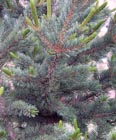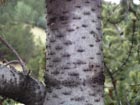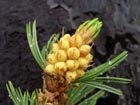Pinus aristata
Engelmann 1863
Common names
Rocky mountain bristlecone pine (Elmore and Janish 1976), hickory pine (Peattie 1950), Colorado bristlecone pine (Kral 1993).
Taxonomic notes
Syn: Pinus balfouriana Greville & Balfour var. aristata (Engelmann) Engelmann (Kral 1993).
Description
"Trees to 15m; trunk to 1m diam., strongly tapering, twisted; crown rounded, flattened (sheared), or irregular. Bark gray to red-brown, shallowly fissured, with long, flat, irregular ridges. Branches contorted; twigs pale red-brown, aging gray, puberulent, young branches resembling long bottlebrushes because of persistent leaves. Buds ovoid-acuminate, pale red-brown, ca. 1 cm, resinous. Leaves 5 per fascicle, upcurved, persisting 10-17 years, (2-)3-4 cm x 0.8-1 mm, mostly connivent, deep blue-green, with drops and scales of resin, abaxial surface with strong, narrow median groove, adaxial surfaces conspicuously whitened by stomates, margins entire or distantly serrulate, apex conic-acute to conic-subulate; sheath 0.5-1.5 cm, scales soon recurving, shed early. Pollen cones ellipsoid, ca. 10 mm, bluish to red. Seed cones maturing in 2 years, shedding seeds and falling soon thereafter, spreading, symmetric, lance-cylindric before opening, lance-ovoid to ovoid or cylindric when open, 6-11 cm, purple to brown, nearly sessile; apophyses much thickened; umbo central, with triangular base, extended into slender, brittle prickle 4-10 mm. Seeds obliquely obovoid; body 5-6 mm, gray-brown to near black; wing ca. 10-13 mm. 2n=24." (Kral 1993).
Needles of Pinus aristata are usually narrower and sharper than in P.longaeva and P.balfouriana, and the leaves almost always have a narrow, median groove on the abaxial surface (Kral 1993).
Distribution and Ecology
USA: Montane to subalpine areas of Colorado, New Mexico and Arizona (the San Francisco Peaks) at elevations of 2300 to 3650 meters (Silba 1986, Kral 1993). See also Thompson et al. (1999). Hardy to Zone 3 (cold hardiness limit between -39.9°C and -34.4°C) (Bannister and Neuner 2001).
Distribution data from USGS (1999). Points plotted as tree icons represent isolated or approximate locations.
Remarkable Specimens
The largest specimen has diameter 107 cm, height 23 m, and crown spread 12 m. It grows in Carson National Forest, New Mexico. Another tree, in Colfax County, has diameter 112 cm, height 22 m, and crown spread 10 m (American Forests 1996).
The oldest tree is recorded by a crossdated age of 2,435 years for specimen CB-90-11, sampled by Brunstein and Yamaguchi in central Colorado (Brunstein and Yamaguchi 1992, Brown 1996).
Ethnobotany
The species has seen a little work in dendrochronology. Brunstein (1996) did an interesting study of frost rings over an impressive 2,500 year time span.
Observations
An ancient timberline grove can be seen along the Auto Road on Mt. Evans, Colorado. This grove has been somewhat vandalized by wood collectors. A more pristine stand can be found at timberline on the San Francisco Peaks of Arizona, although this requires a half-day walk to visit. The species also occurs as an early successional montane forest tree; in this role, it is plentiful in the western Pikes Peak area or Colorado, from the lower Peak west to the Woodland and Cripple Creek areas.
Remarks
The epithet aristata is from the Latin arista meaning an ear (as of corn) and refers to the long bristles on the seed cone scales.
White pine blister rust (Cronartium ribicola), an introduced fungal disease, has afflicted this and certain other white pines (Peattie 1950).
On the San Francisco Peaks, this species is a principal host for the dwarf mistletoe Arceuthobium microcarpum (Hawksworth and Wiens 1996).
Citations
American Forests 1996. The 1996-1997 National Register of Big Trees. Washington, DC: American Forests.
Brunstein, F. C. 1996. Climatic significance of the bristlecone pine latewood frost-ring record at Almagre Mountain, Colorado, U.S.A. Arctic and Alpine Research 28(1): 65-76.
Engelmann, G. 1863. On Pinus aristata, a New Species of Pine, discovered by Dr. C. C. Parry in the Alpine Regions of Colorado Territory, and on some other Pines of the Rocky Mountains. Transactions of the Academy of Science of St. Louis 2:205. Available at the Biodiversity Heritage Library, accessed 2021.12.16. [Note on publication date]
See also
Brunstein, F. C. 2006. Growth-form characteristics of ancient Rocky Mountain bristlecone pines (Pinus aristata), Colorado. U.S. Geological Survey Scientific Investigations Report 2006-5219, 90 p. Available: http://pubs.usgs.gov/sir/2006/5219/, accessed 2008.01.07.
Elwes and Henry 1906-1913 at the Biodiversity Heritage Library. This series of volumes, privately printed, provides some of the most engaging descriptions of conifers ever published. Although they only treat species cultivated in the U.K. and Ireland, and the taxonomy is a bit dated, still these accounts are thorough, treating such topics as species description, range, varieties, exceptionally old or tall specimens, remarkable trees, and cultivation. Despite being over a century old, they are generally accurate, and are illustrated with some remarkable photographs and lithographs.
FEIS database.
Schauer, A. J., A. W. Schoettle, and R. L. Boyce. 2001. Partial cambial mortality in high-elevation Pinus aristata (Pinaceae). American Journal of Botany 88:646-652. Available: http://www.amjbot.org/cgi/content/full/88/4/646, accessed 2008.01.07.







